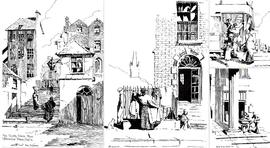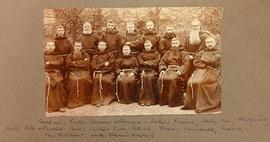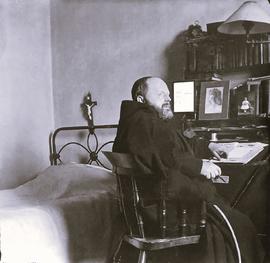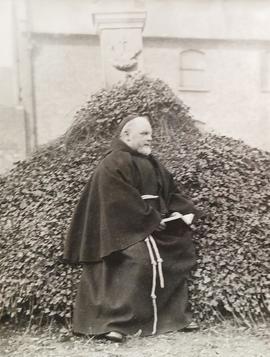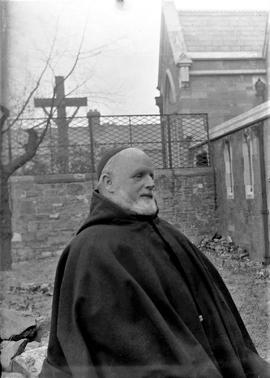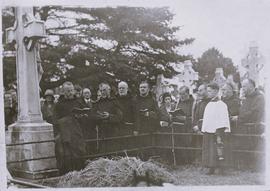A volume titled ‘Blocks / Father Mathew Record / The Capuchin Annual / subjects: Capuchins / Saints / Beati / Friars / Friaries / Houses / Colleges’. The volume contains printed copies of block pulls for photographs and illustrations published in 'The Capuchin Annual'. The volume includes the following copy prints:
• Fr. Casimir Butler OFM Cap., Fr. Declan McFadden OFM Cap. and Fr. Alban Cullen OFM Cap.
• The garden of the Capuchin Friary, Church Street, Dublin.
• Certificate of reception of Cardinal Joseph McRory, Archbishop of Armagh, into the Third Order of St. Francis. 11 Mar. 1928.
• The Capuchin Friary, Rochestown, County Cork.
• Irish Capuchin houses in France in the eighteenth century.
• Engraving of Father Mathew Hall, Church Street, Dublin.
• Students in Rochestown College, County Cork.
• Drawings by Fr. Gerald McCann OFM Cap.
• General Chapter of the Capuchin Order in Rome, 1926.
• Cardinal Guglielmo Massaia OSFC (1809-1889).
• A group of Irish Capuchin students in Rome.
• Cartoons by Tom Lalor.
• The exterior of the old Capuchin Chapel on Church Street (c.1861).
• The Most Rev. Thomas-Louis Connolly OSFC (1814-1876), Archbishop of Halifax.
• Views of Dublin life, a collection of drawings by Seán MacManus.
• Fr. Sebastian O’Brien OFM Cap. (1867-1931).
• A view of Church Street looking northwards towards North King Street.
• Mary Redmond (1863-1930), sculptor.
• Fr. Augustine Hayden OFM Cap. (1870-1954).
• Fr. Dominic O’Connor OFM Cap. (1883-1935) in the United States.
• Fr. Stanislaus Kavanagh OFM Cap. (1876-1965).
• Depictions of St. Francis and various Capuchin Franciscan Saints.
• Capuchin Franciscan bishops.
A group of Capuchin priests and novices in the garden of the Church Street Friary in Dublin. A manuscript annotation provides the names of the friars. The group includes Aloysius Travers OFM Cap., Sebastian O’Brien, Stanislaus Walsh OFM Cap., Peter Bowe OFM Cap., Laurence Dowling OFM Cap., Paschal Stapleton OFM Cap., and Luke Sheehan OFM Cap.
The Catholic Boys’ Brigade was founded by Fr. Benvenutus Guy OSFC (1860-1927), a Capuchin friar, in March 1894. Mainly composed of impoverished children from the Church Street area, the organisation was initially called St. Joseph’s Boys’ Brigade. The stated objects of the Brigade were ‘to crush vice and evil habits among boys, to instruct them thoroughly in the Christian doctrine … to give them habits of obedience, discipline, and self-respect and love for ecclesiastical authority and holy religion and to promote their moral, physical and temporal well-being’. The idea of forming a Brigade for the Catholic boys of Dublin sprung from the success achieved by the Protestant Boys’ Brigade. The first meeting hall of the Brigade was in a house in Smithfield which was rented at 5s per week. This meeting was held on 24 April 1894 with nine boys in attendance. The organisation grew rapidly. The Brigade Hall was soon relocated to a property (formerly a smelting foundry) at 156 Church Street which was purchased for the sum of £300. The organizing committee also succeeded in obtaining the use of an old vegetable market at the rear of the Hall which was used as a drill yard in 1895. The newly furnished hall and gallery could hold 1,500 attendees. A uniform was supplied to each enrolled boy consisting of a sash, a cap and a badge. An important aspect of the Brigade’s activities was physical exercise and participants routinely trained in ‘physical drilling, figure marching, squad and company drills’. A band was also established under the supervision of Fr. Sebastian O’Brien OSFC (1867-1931). A night-school for instructing illiterate young boys was founded in October 1899 and soon attracted thirty-five students. Religious instruction was supplied by the Capuchin friars. This was initially performed by Fr. Benvenutus Guy OSFC and later by Fr. Paul Neary OSFC (1857-1939). In 1904 the Church Street Capuchins transferred trusteeship of the properties owned by the Catholic Boys’ Brigade to lay stewardship.
A glass stereo plate of what appears to be deceased Capuchin friar in a coffin. This is probably an image of a deceased Fr. Sebastian O’Brien OFM Cap. (1867-1931). A duplicate of this plate is extant at CA-PH-1-36-C.
A stereo plate showing an unidentified deceased Capuchin friar. The scene also shows a nurse and another individual. This is probably an image of a deceased Fr. Sebastian O’Brien OFM Cap. (1867-1931).
A photograph of Fr. Sebastian O’Brien OFM Cap.
A photograph of Fr. Sebastian O’Brien OFM Cap. seated in the garden of the Capuchin Friary on Church Street in Dublin.
An image of Fr. Sebastian O’Brien OFM Cap. (1867-1931) sitting in the garden of the Church Street Friary. With an annotated cover.
A photograph of the funeral of Fr. Sebastian O’Brien OFM Cap. in Glasnevin Cemetery in Dublin. Fr. Ignatius Collins OFM Cap., Fr. Senan Moynihan OFM Cap., Fr. Stanislaus Kavanagh OFM Cap., and Fr. Columbus Murphy OFM Cap. are among those at the graveside.
General house receipts for 1926 to 1934. Includes bills of costs and receipts associated with the funeral expenses of Fr. Peter Bowe OSFC, former Provincial Minister (d. 24 Nov. 1926), and Fr. Sebastian O’Brien OSFC (1867-1931).
